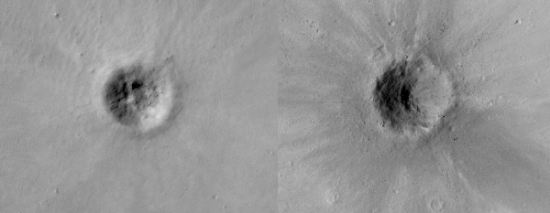Aug 14, 2014
Not all features on Mars are electrical scars.
It is often said that to the man with a hammer, everything looks like a nail. Many times, Electric Universe advocates are accused of having too narrow an outlook, as if all that can be observed is the result of giant lightning or some other form of plasma event.
Recently, an image from the Mars Reconnaissance Orbiter’s (MRO) High Resolution Imaging Science Experiment (HiRise) has appeared in several online publications. This has prompted many questions from readers about its origins: is it the result of an electrical discharge, or is it an astrobleme?
At the top of the page is an extremely deep zoom into the crater itself, side-by-side with another relatively recent crater, also discovered on Mars by MRO. Since HiRise is capable of resolving objects less than one meter in diameter on the surface from an altitude of approximately 320 kilometers, it is possible to look closely at features that were previously unseen.
Many Picture of the Day articles insist that electricity plays a substantial role in the morphology of planets and moons, although it is unrecognized by consensus science as a formative influence. Most large craters on Mars are electrical in nature. They can be recognized by their steep sides, sharp rims, flat floors, a lack of blast debris inside the craters or strewn around them, fulgurites embedded in the sidewalls, and, sometimes, other craters on their rims.
When electricity passes over a solid body, such as a planet, the current pulls charged material from the contact surface. Neutral dust and stones will be pulled along with the ionized particles, as well. Craters formed by electric arcs are also circular because electromagnetic forces cause them to maintain right angles to the impact zone. Since two or more filaments rotate around the arc axis, it can behave like a drill, excavating the aforementioned steep side walls.
If the surface is negatively charged, an arc will travel, sometimes eroding elongated craters. The arc might jump from high point to high point. Smaller craters on the rims of larger ones reveal this phenomenon. A series of craters in a line, otherwise called a “crater chain,” is another sign of arcing to a negatively charged substrate.
Evidently, the two craters under consideration do not share those characteristics. They have rounded rims, there are debris fields, they do not have flat floors, they do not have steep walls, and there are no fulgurites embedded in them. The right-hand image, when viewed in the highest resolution, reveals definitive signs of impact. There is a crescent-shaped trench, as well as indications that the meteor hit the surface at an oblique angle.
It is important that context always be included when discussing Electric Universe ideas. One of the theory’s major premises is that whatever devastated Mars and the other planets and moons took place between 5000 and 10,000 years ago in a much more electrically active Solar System. What caused that catastrophe is impossible to determine at this late date. Whether it was the disruption of planets in their orbits, a gigantic CME, or an increase in electrical input from the galaxy is not germaine to the point. Regardless of the source, today’s Solar System is nothing like it once was.
Stephen Smith













